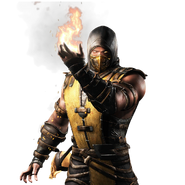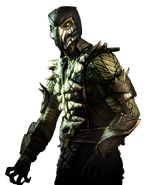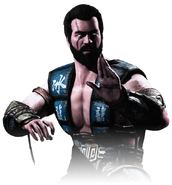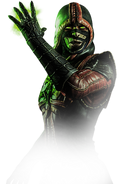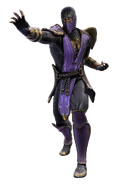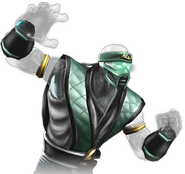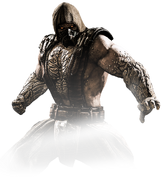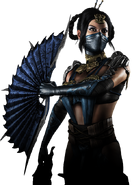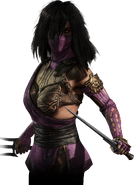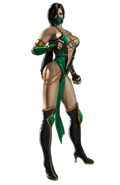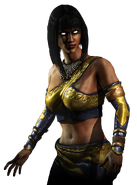No edit summary |
No edit summary |
||
| Line 69: | Line 69: | ||
*[[Frost]] is supposed to be a Ninja as she is a member of the [[Lin Kuei]] However she lacks a signature weapon to be included among the female Ninja, being more fitting in the male section as a "female Sub-Zero" furthermore she's not part of [[Khameleon]] moveset in Armageddon. |
*[[Frost]] is supposed to be a Ninja as she is a member of the [[Lin Kuei]] However she lacks a signature weapon to be included among the female Ninja, being more fitting in the male section as a "female Sub-Zero" furthermore she's not part of [[Khameleon]] moveset in Armageddon. |
||
**While [[Skarllet]] isn't either in Khameleon moveset that's because she was only added as a playable character aftwards in the series |
**While [[Skarllet]] isn't either in Khameleon moveset that's because she was only added as a playable character aftwards in the series |
||
| + | |||
*[[Takeda Takahashi]] also is supposed to be a Ninja as he is a member of the [[Shirai Ryu]] but lacks it's own signature color and classic pallet swap outfit. |
*[[Takeda Takahashi]] also is supposed to be a Ninja as he is a member of the [[Shirai Ryu]] but lacks it's own signature color and classic pallet swap outfit. |
||
| + | |||
*[[Reiko]], who was introduced in ''[[Mortal Kombat 4]]'', was created by modifying Noob Saibot's then-unused model into a new character, creating an unmasked magenta-colored ninja. Reiko has long since abandoned this design for a look modelled after [[Shao Kahn]], and is generally not grouped with the ninja archetype. |
*[[Reiko]], who was introduced in ''[[Mortal Kombat 4]]'', was created by modifying Noob Saibot's then-unused model into a new character, creating an unmasked magenta-colored ninja. Reiko has long since abandoned this design for a look modelled after [[Shao Kahn]], and is generally not grouped with the ninja archetype. |
||
Revision as of 21:39, 8 June 2018
Ninjas are a common character type featured in the Mortal Kombat series.
Overview
Ninja is a loosely used term in the actual sense of ninjas regarding the Mortal Kombat franchise, thus they are a very prominent group of characters. It is not uncommon for a ninja to possess supernatural powers that gives them the edge over their opponents. From Mortal Kombat to Mortal Kombat Trilogy, ninjas were virtually identical to one another in terms of appearance, save for their color choices, poses and powers. From Mortal Kombat 4 onwards, ninjas were given a better sense of diversity with their designs.
The general consensus of the word "Ninja" meaning in the series is that:
Ninja= Characters who in their first appearance shared the same outfit being pallet swaps of each other, each one with it's matching color and attribute (For the males) or Weapon (For the Females) whether or not they should be considered "Ninjas" by the real life meaning of the word.
Note that the Cyborgs are not included in the Ninja archetype although they are originated from pallet swaps, due to being Cyborgs they are considered to be "Cyber-Ninjas".
Ninjas
Follows the list of Ninjas and their respective Color & Attribute/Weapon
Male:
- Sub-Zero (Blue-Ice)
- Scorpion (Yellow-Fire)
- Reptile (Green-Acid)
- Smoke (Gray-Steam)
- Noob Saibot (Black-Shadow)
- Ermac (Red-Telekinesis)
- Rain (Purple-Weather)
- Chameleon (All above mentioned)
- Tremor (Brown-Earth)
Female:
- Kitana (Blue-Steel Fans)
- Mileena (Pink-Sai)
- Jade (Green-Bo/Cyclone Thrower)
- Tanya(Yellow-Kobojutsu)
- Khameleon(All above mentioned)
- Skarlet (Red-Kodachi Swords)
Cyber-Ninjas
Behind the scenes
In reality, all of the ninja characters in the first three Mortal Kombat games were all represented by a single actor. The original base costume was of a red color to avoid blending in with the blue background used when filming the characters for the sprites. This method was used because of memory limitations and an attempt to get more playable characters for the roster. The ninja actor had to perform a wider array of moves and multiple fighting stances than the others as they would be "portraying" multiple characters at once. Once the sprites were captured, they were digitally recolored, creating color values to be applied to the numerous characters. These values were programmed and coded to be treated as separate character values, having access to certain sprites and individual special moves to create their identities.
Because of this, there is a possibility to 'unlock' access to all of these sprites to any ninja, granting them different abilities by swapping movesets or give them every single special move. This would eventually be explored by the Mortal Kombat Trilogy hidden characters Chameleon and Khameleon, as well as Mortal Kombat X's DLC character Triborg, several years later.
Unlike most other characters grouped with this archetype, Tanya did not necessarily originate from a palette swap.
Before Mortal Kombat (2011) was released, it was announced that pre-ordering from certain stores would provide a code to unlock classic ninja outfits, with their Mortal Kombat (1992) outfits for the male ninjas and their Ultimate Mortal Kombat 3 outfits for the females. Jade was an exception, with her classic outfit code being provided by purchasing the Blu-ray edition of the Mortal Kombat films. A DLC pack was later released which featured all of the classic outfits from pre ordering the game.
With each DLC character released, two classic outfits would be released with the compatibility packs.
With Skarlet's release, her compatibility pack provided a classic outfits for Cyrax and Sektor, based on their Mortal Kombat 3 outfits.
With Kenshi's release, his compatibility pack provided a classic outfit for Smoke and Noob Saibot, based on their Mortal Kombat II outfits.
With Rain's release, his compatibility pack provided a classic outfit for Kitana and Jade, based on their Mortal Kombat II outfits.
With Freddy Krueger's release, his compatibility pack provided a classic outfit for Sub-Zero, based on his Mortal Kombat 3 appearance as well as an outfit based on the classic cyber ninja outfits for Cyber Sub-Zero.
In the Playstation Vita port of the game, the MK and MKII outfits were available from the outset. All of the ninjas, including Rain and Skarlet, were given UMK3 outfits, with Sub-Zero receiving a proper masked outfit to go with his maskless appearance (which is labeled as "UMK3" whereas the others are simply labeled "MK3"). Skarlet also received an MKII outfit based on her rumored appearance, though retaining her hair color. Rain's UMK3 outfit in particular is unlockable by completing the final mission in the Bonus Challenge Tower.
Mortal Kombat X continued the tradition by giving Scorpion, Sub-Zero, Ermac, and Reptile their UMK3 outfits (with Reptile being given an altered version of his mask) as free costumes with each successive update, while Kitana and Mileena's MKII costumes were available as unlocks through the mobile game. In addition, Scorpion, Ermac and Sub-Zero were given a stylized, metallic version of Scorpion's MKX appearance, with Scorpion's being exclusive as a Kollector's Edition bonus while Ermac's and Sub-Zero's can be purchased normally.
Trivia
- Frost is supposed to be a Ninja as she is a member of the Lin Kuei However she lacks a signature weapon to be included among the female Ninja, being more fitting in the male section as a "female Sub-Zero" furthermore she's not part of Khameleon moveset in Armageddon.
- While Skarllet isn't either in Khameleon moveset that's because she was only added as a playable character aftwards in the series
- Takeda Takahashi also is supposed to be a Ninja as he is a member of the Shirai Ryu but lacks it's own signature color and classic pallet swap outfit.
- Reiko, who was introduced in Mortal Kombat 4, was created by modifying Noob Saibot's then-unused model into a new character, creating an unmasked magenta-colored ninja. Reiko has long since abandoned this design for a look modelled after Shao Kahn, and is generally not grouped with the ninja archetype.

